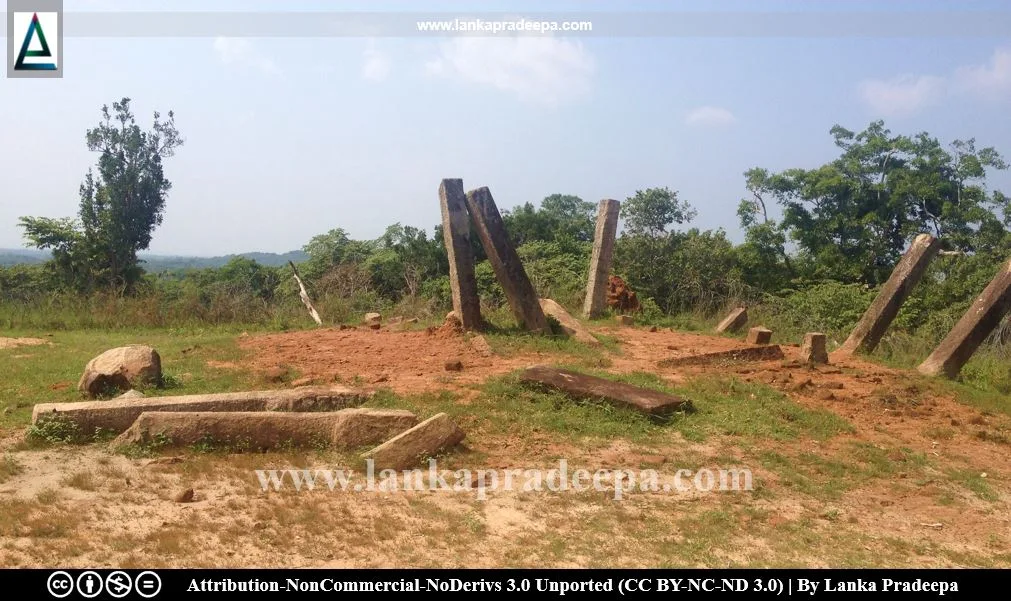
|
The Kota Vehera Stupa |
Kota Vehera, also known as Kotaveheragala Viharaya (Sinhala: ලාහුගල කොට වෙහෙර), is a Buddhist temple situated in Lahugala in Ampara District, Sri Lanka. It is erected on a small hillock situated on the verge of the Lahugala-Kitulana National Park. The ancient Magul Maha Viharaya is located about 2.8 km southwest of this site.
History
The history of this temple runs back to the early Anuradhapura Period (Vithanachchi, 2013). The inscriptions discovered in situ have revealed that this temple was known in ancient times as "Digalaka Maha Vehera" (Gamage, 2020; Vithanachchi, 2013).
According to the opinion of Medhananda Thera, this temple could be the ancient Kotapabbatha Viharaya that is mentioned in the chronicle Mahavamsa (Medhananda, 2003). As revealed by Mahavamsa, Kotapabbatha Viharaya was the home for the novice monk who was reborn as King Dutugemunu [(161-137 B.C.) Medhananda, 2003].
Monuments
A number of the ruins including rock inscriptions, rock-cut steps, caves, Sri Pathul Gal (footprints of Buddha), and pillars of ancient structures are found on the temple premises. The large Stupa built in accordance to the Kota Vehera style is considered the main monument of the site. The Chatra and the Yupa stone, found near the Stupa indicate that it was built in the form of the early Stupas of the country. A few reliquaries recovered from the Kota Vehara are presently on display at the National Museum of Colombo.
Reliquaries of Kota Vehera

Period: 1st - 2nd century A.D.
Height: 7.8 cm (golden reliquary)
Description: The gold reliquary has been made of gold sheets arranged in a flower fashion and was originally sheltered by a series of Chatras which are now missing. This reliquary, together with other similar ones discovered from Delivala and Mihintale, represents the form of the early Stupas of Sri Lanka as well as India. The other two reliquaries made of crystals were also popularly used in ancient times in Sri Lanka.
Reference: National Museum of Colombo.
Inscriptions
Eleven inscriptions ranging from the 1st to 6/7th centuries A.D. are discovered at the site.
Reign: King Bhathikabhaya (19 B.C.-9 A.D.) Period: 1st century A.D.
Script: Later Brahmi Language: Old Sinhala
Transcript: Siddam! Devanapiyatisa rajaha marumakanakaha kutakana rajahaputa Gamini Abaya...
Translation: Hail! Gamini Abaya, son of Kutakanna Tissa, grandson of king Devanampiya Tissa...
Reference: The information board by the Department of Archaeology and the State Ministry of Cultural Affairs
Reign: King Gajabahu I (114-136 A.D.) Period: 2nd century A.D.
Script: Later Brahmi Language: Old Sinhala
Content: Sabaya, the minister of King Gamini Abhaya (Gajaba) having exempted from taxes a hundred karises (400 amunas) of paddy land under Digalaka tank, donated it to Digalaka Vihara. Furthermore, ten karises (40 amunas) of paddy land were offered for the activities of the Cetiya and one karisa (4 amunas) has been donated for the lightning lamp at the Stupa
Reference: The information board by the Department of Archaeology and the State Ministry of Cultural Affairs
A Protected Site
The Buddhist monastery complex with archaeological evidence including ancient Dagaba, building sites with stone pillars, flights of steps carved on natural rock plain, and drip-ledged caves located in the place called "Kota Wehera" belonging to Lahugala village in Pansalgoda Grama Niladari Division in the Divisional Secretary’s Division, Lahugala is an archaeological protected site, declared by a government gazette notification published on 10 October 2014.



Related Posts
Read Also
References
Books, Government Gazette Notifications
1) Gamage, D.P., 2020. Epigraphical Notes (Nos. 22-23). Department of Archaeology. ISBN: 978-955-7457-30-7. pp.74-80.
2) Medhananda, Ven. Ellawala, 2003. Pacheena passa - Uttara passa: Negenahira palata ha uturu palate Sinhala bauddha urumaya (In Sinhala).
Dayawansa Jayakody & Company. Colombo. ISBN: 978-955-686-112-9.
pp.143-145.
3) The Gazette of the Democratic Socialist Republic of Sri Lanka, no: 1884. 10 October 2014, p. 917.
4) Vithanachchi, C. R., 2013. Pauranika Sthana Saha Smaraka: Ampara Distrikkaya (In Sinhala). Department of Archaeology (Sri Lanka). ISBN: 955-9159-44-5. pp.27-28.

